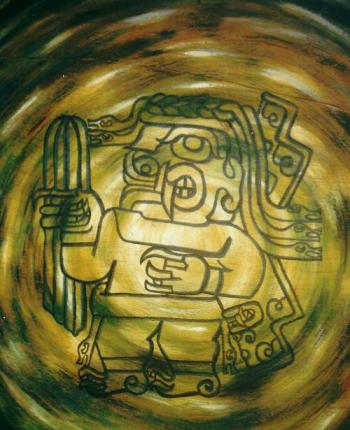
This Sacred Plant has been used for thousands of years by our ancestral cultures, as the clearest evidence on the use of San Pedro in ancient times, is related to the Chavín culture which developed in the Northern part of Peru, around 3,500 years ago. Although, we suppose that its use must date back to many centuries before the formation of Chavín and Huachuma has continued to be used through history and up to our present days, by the Mochica, Chimú, Nasca, Tihuanaco, Wari cultures, etc.
The Huachuma Sacred Medicine was one of the main Teacher Plants used during the Incan period, for the preparation of different Sacred Beverages.
The name “San Pedro” comes from the colonial period and the belief goes that it was given to that plant, as a relation was made with the Christian Saint who was in charge of the keys of Heaven.
The Huachuma is a cactus scientifically called Trichocereus, of which exist several varieties and two of them have widely been used as part of the preparation of Sacred Beverages and these are: Trichocereus pachanoi and Trichocereus peruvianus.
The Sapan Inka Retreat Centre uses this ancient medicine as part of the Ayahuasca Retreats. The San Pedro is used to complement the use of ayahuasca. According to the way we use this medicine, San Pedro ritual is performed only after passing through a cleaning process with Ayahuasca medicine. San Pedro medicine plant has a different effect to Ayahuasca, usually the non-ordinary state of consciousness experienced with San Pedro is about 12 to 15 hours long. San Pedro ceremonies organized by Sapan Inka project normally are during the day.
 We drink the medicine and immediately after, we participate in an incan ancestral ritual led by an Andean priest or pampamesayoq, this ritual is known as a despacho, it is a thanks offering to the spirit or energy of the mother earth, and to the spiritual power of the mountains. The intention for this ritual is for “flowering”, and its meaning is a symbolic connection, looking forward harmony in the material and spiritual world: peace, joy and prosperity. While this ritual is performed, effects of San Pedro start. After the ancestral ritual, the work with San Pedro continues on the sacred mountain. Working with San Pedro is an inner process of self-healing, connecting with ourselves and with the energy of nature, where a state of expanded consciousness is lived, a psycho emotional openness is experienced, and we are able to understand more about our inner nature and the internal structure of the soul. The state of consciousness experienced with the San Pedro helps to understand more clearly the cleaning process has been experienced during ayahuasca ceremonies. It provides, in general, a larger self-knowledge.
We drink the medicine and immediately after, we participate in an incan ancestral ritual led by an Andean priest or pampamesayoq, this ritual is known as a despacho, it is a thanks offering to the spirit or energy of the mother earth, and to the spiritual power of the mountains. The intention for this ritual is for “flowering”, and its meaning is a symbolic connection, looking forward harmony in the material and spiritual world: peace, joy and prosperity. While this ritual is performed, effects of San Pedro start. After the ancestral ritual, the work with San Pedro continues on the sacred mountain. Working with San Pedro is an inner process of self-healing, connecting with ourselves and with the energy of nature, where a state of expanded consciousness is lived, a psycho emotional openness is experienced, and we are able to understand more about our inner nature and the internal structure of the soul. The state of consciousness experienced with the San Pedro helps to understand more clearly the cleaning process has been experienced during ayahuasca ceremonies. It provides, in general, a larger self-knowledge.
Huachuma is an ancestral Incan medicine that has the potential to provide to some persons a connection to dominant archetypes of the collective unconscious. This powerful medicine can lead to states of consciousness in which it is possible to achieve a dissolution of unconscious complexes rooted in the personality, but to really get benefits, it is needed to be used together to techniques of psychic and spiritual knowledge, in this way it is possible a re-integration of the non-ordinary state of consciousness experienced after dinking the sacred medicine. Sometimes it is possible to make the healing process during the full moon night, according to weather and energetic conditions. Traditionally Huachuma medicine has a relationship with the lunar phases. Unlike Ayahuasca, using this medicine it is possible to walk during the day and it is possible to feel expansion of senses.
Occidental scientists have performed several studies on that Sacred Plant and the main component they discovered in it has been called mescaline; a substance that was also found in another Sacred Plant from Mexico, called Peyote. The name mescaline was a mistake on the part of the scientists who analyzed a sample of the cactus, giving it the name of "botones de mescal", instead of its real name which is "botones de peyote". The first experience with mescaline was performed in 1897 and the first total synthesis of the compound took place in 1919, as this was the first isolated and purified entheogen substance extracted from a plant.
There are several ways of preparing that medicine: The plant can be consumed fresh and raw or dry and pulverized, adding water and honey to it in a cooking process that lasts several hours. It can also be prepared in a mixture with other medicinal plants. It is recommended that the doses should be administered by the Healer who knows the medicine's preparation.